Magnesium and potassium go hand-in-hand in regulating blood pressure. But that's not all these minerals do.
Magnesium is vital for managing nerve and muscle function, regulating blood pressure and blood sugar, and making protein and DNA, according to the National Institutes of Health (NIH). There are different kinds of magnesium, too, like magnesium citrate, magnesium glycinate and magnesium oxide, all with different functions.
Video of the Day
Video of the Day
Potassium helps contract muscles, relax blood vessels, keep the heart and kidneys healthy and support cell function, according to the NIH.
How Much Magnesium and Potassium Do You Need?
Adults assigned male at birth need 400 to 420 milligrams of magnesium per day, while adults assigned female at birth need 310 to 320 milligrams per day, per the NIH.
For potassium, the NIH recommends a daily intake of 3,400 milligrams for adults assigned male at birth and 2,600 milligrams for adults assigned female at birth.
The top magnesium-rich foods are grains, nuts, legumes, fish and leafy green vegetables. Meanwhile, foods high in potassium include fruits and vegetables, milk and yogurt, legumes, nuts, meat and poultry. But finding picks with both nutrients can sometimes be a challenge.
Look to the foods high in magnesium and potassium list below and note that the Food and Drug Administration (FDA) calculates its Daily Value (DV) percentages based on eating 420 milligrams of magnesium and 4,700 milligrams of potassium per day.
1. Swiss Chard
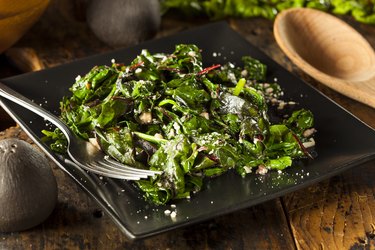
Per 1 cup:
- Magnesium: 150.5 mg, 36% DV
- Potassium: 960.8 mg, 20% DV
It may come as no surprise that leafy green vegetables are rich in nutrients and Swiss chard is no exception. Not only is this vegetable an excellent source of magnesium and potassium, but it's also high in iron and vitamins A, C, E and K. One cup of cooked Swiss chard offers 36 percent magnesium DV and 20 percent DV of potassium, according to the USDA.
2. Edamame
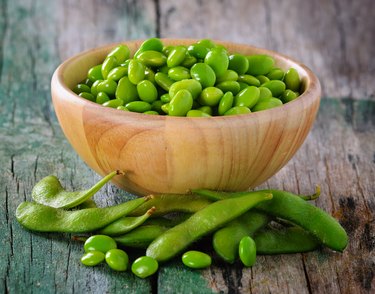
Per 1 cup:
- Magnesium: 147.9 mg, 35% DV
- Potassium: 885.8 mg, 19% DV
Edamame, or green soybeans, are high in protein and fiber, making them incredibly filling as a snack or plant-based protein base for any meal. You'll get 35 percent of the magnesium DV and 19 percent DV of potassium in 1 cup of cooked edamame. But the nutrient load doesn't end there: These green soybeans are rich in folate, manganese, copper, thiamin and vitamin K.
3. Spinach

Per 1 cup:
- Magnesium: 156.6 mg, 37% DV
- Potassium: 838.8 mg, 18% DV
If you're looking for a healthy dose of magnesium and potassium but don't like the slightly bitter taste of Swiss chard, spinach has your back. One cup of cooked spinach provides 37 percent of the magnesium DV and 18 percent DV of potassium.
Spinach is also rich in folate and vitamins A, C and E. All of these nutrients, along with magnesium, are essential for a healthy immune system to fight against infection, according to a January 2020 review published in Nutrients. Try roasting spinach instead of steaming it for a more flavorful side dish.
4. Cannellini Beans
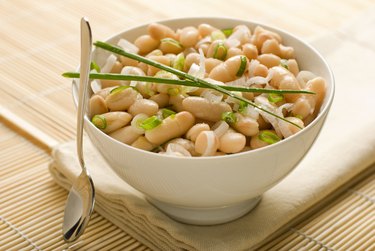
Per 1 cup:
- Magnesium: 112.8 mg, 27% DV
- Potassium: 1004.2 mg, 21% DV
Cannellini beans are large white beans that are sometimes referred to as white kidney beans. Just 1 cup of cooked cannellini beans provides you with 27 percent magnesium DV and 21 percent DV of potassium.
Legumes (like cannellini beans) are high in fiber and plant-based protein, contributing to their wide range of health benefits. For example, a diet containing at least 1 cup of legumes per day is tied to a reduced risk of heart disease and helping regulate blood sugar and blood pressure in people with type 2 diabetes, according to a November 2012 study in Archives of Internal Medicine. Try them in these protein-packed bean recipes.
5. Acorn Squash

Per 1 cup:
- Magnesium: 88.1 mg, 21% DV
- Potassium: 895.9 mg, 19% DV
Acorn squash is a nutritious winter squash similar to delicata and butternut squash and ranks high on the list of vegetables with potassium and magnesium. It tastes best when it is boiled and mashed, roasted or baked. One cup of cooked acorn squash contains vitamin C, 32 percent of the DV of fiber, 21 percent of the magnesium DV and 19 percent of the potassium DV.
6. Salmon
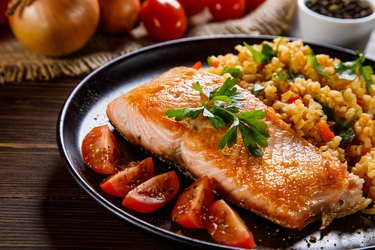
Per 6-ounce serving:
- Magnesium: 62.9 mg, 15% DV
- Potassium: 1067.6 mg, 23% DV
Salmon is probably best known for being one of the best foods high in omega-3 fatty acids. But that's not all that this fatty fish is good for. A 6-ounce fillet of cooked wild salmon offers 23 percent potassium DV and 15 percent DV of magnesium. It's also high in protein, vitamins B6 and B12, folate and selenium.
The American Heart Association (AHA) recommends eating fatty fish like salmon twice a week to reap the benefits for heart health. Plus, the omega-3s in salmon are linked to a reduced risk of Alzheimer's disease, according to Harvard Health Publishing. Try these healthy and easy salmon recipes next time you're making dinner.
7. Avocados
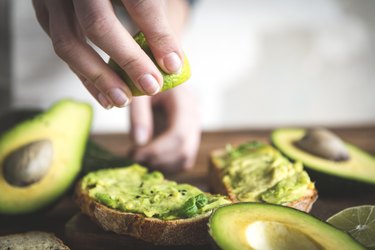
Per 1 whole avocado:
- Magnesium: 58.3 mg, 14% DV
- Potassium: 974.9 mg, 21% DV
Avocados became so popular that there was a global shortage for several years, yet that doesn't stop people from adding this magnesium-rich fruit to their grocery lists. Whether or not you're still getting over the fact that avocados are not vegetables, you can't deny that they are quite nutritious and provide plenty of healthy, unsaturated fats, folate and vitamins C, E and K.
Avocados might not be the first food that comes to mind when you think of fruit with potassium and magnesium. But with 21 percent of the DV of potassium and 14 percent of the magnesium DV in one whole avocado, they offer more of these nutrients than many other fruits (for reference, there's only 10 percent DV potassium and 9 percent of the DV of magnesium in a banana). Try these creative avocado recipes that go beyond avocado toast and guacamole.
8. Potatoes
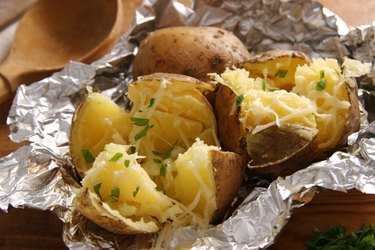
Per 1 medium potato:
- Magnesium: 48.4 mg, 12% DV
- Potassium: 925.6 mg, 20% DV
Potatoes don't get the credit they deserve. While some people tout taters as unhealthy because they're not low-carb, they are actually quite nutrient-packed (as long as you're not deep-frying them).
You get 20 percent of the potassium DV and 12 percent DV of magnesium in one medium baked potato with skin, as well as vitamins C and B6, iron, protein and 14 percent of the DV of fiber. Yes, eating potatoes with the skin makes a big difference: The skin contains many nutrients, including about half of the fiber in potatoes. So give it a good wash and scrub and avoid peeling if you can, and try these healthy potato recipes.
- National Institutes of Health: "Magnesium"
- National Institutes of Health: "Potassium"
- FDA: "Daily Value on the New Nutrition and Supplement Facts Labels"
- Nutrients: "A Review of Micronutrients and the Immune System–Working in Harmony to Reduce the Risk of Infection"
- Archives of Internal Medicine: "Effect of legumes as part of a low glycemic index diet on glycemic control and cardiovascular risk factors in type 2 diabetes mellitus: a randomized controlled trial"
- American Heart Association: "Fish and Omega-3 Fatty Acids"
- Harvard Health Publishing: "What to eat to reduce your risk of Alzheimer’s disease"
- My Food Data